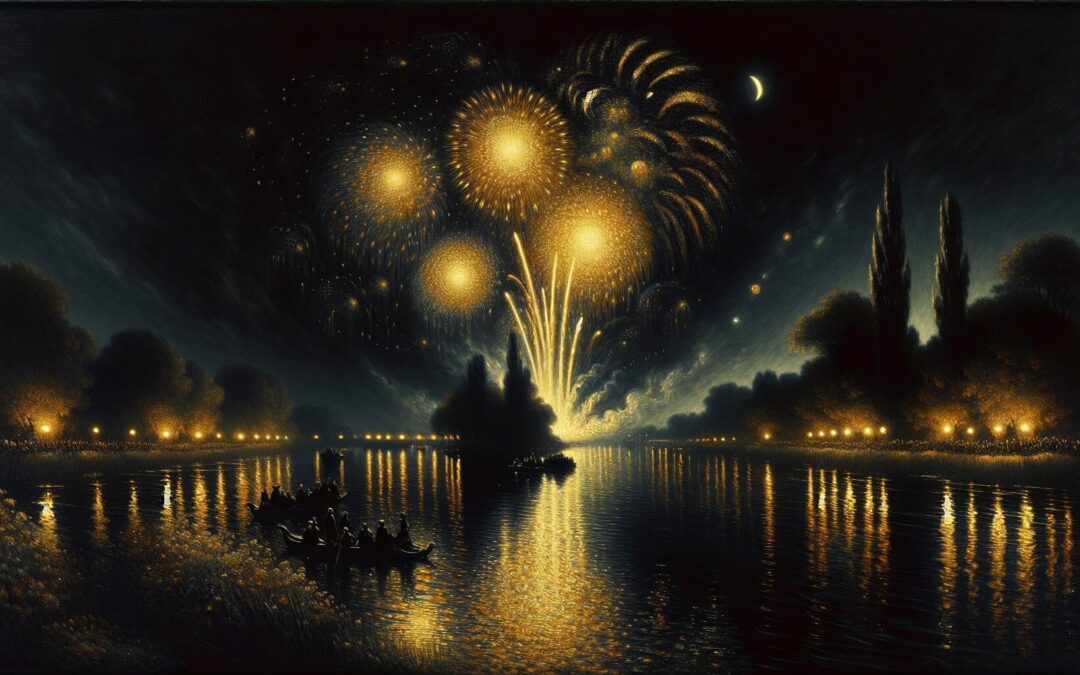The Nocturne in Black and Gold: The Falling Rocket, painted by James Whistler in 1875, stands as a pivotal moment in art history. This masterpiece not only showcases Whistler’s innovative approach to color and composition but also marks the emergence of a new artistic genre. By capturing the ethereal beauty of fireworks against a darkened sky, Whistler invites viewers into a world where emotion and atmosphere reign supreme. This iconic work challenges traditional artistic conventions and lays the groundwork for the Impressionist movement. Whistler’s ability to evoke mood through subtle hues and soft forms highlights the power of suggestion in art. As we delve into the significance of this nocturne, it becomes clear that it’s more than just a painting; it’s a revolutionary statement that reshaped the way artists perceive and depict the world around them.
The Iconic Nocturne in Black and Gold: The Falling Rocket
James Whistler’s painting, “The Nocturne in Black and Gold: The Falling Rocket,” created in 1875, represents a pivotal moment in art history. Whistler’s innovative approach to color and composition redefined visual representation, moving beyond traditional methods. The artwork features a mesmerizing display of fireworks in a night sky, characterized by its muted tones and dynamic brushwork.
The painting embodies the essence of the nocturne genre, where the focus rests on capturing the mood rather than clearly delineating details. Subtle variations in color and texture reflect movement and emotion, showcasing Whistler’s mastery in conveying atmosphere. Critics initially dismissed the piece for its abstraction, but it later gained recognition for its groundbreaking significance.
This artwork played a crucial role in the Impressionist movement, influencing subsequent generations of artists. Its emphasis on aesthetic experience over exact representation marked a departure from academic conventions. “The Nocturne in Black and Gold” remains a seminal work that illustrates the transformative nature of art during the late 19th century.
This iconic piece stands as a testament to Whistler’s vision and artistic innovation, signaling the birth of a new artistic direction. The painting invites viewers to engage with art on a deeper emotional level, framing the evening’s ambiance amidst the splendor of fireworks.
Artistic Significance
James Whistler’s “The Nocturne in Black and Gold: The Falling Rocket” holds substantial artistic significance, marking a turning point in the evolution of modern art. This painting not only showcases Whistler’s mastery of color but also elevates the concept of mood in visual representation.
Historical Context
Created in 1875, the painting emerged during a period of rapid artistic experimentation. Whistler’s work reflects the shift from strict realism to a focus on impression and emotion. Influenced by the Aesthetic Movement, which prioritized beauty and sensory experiences, Whistler’s nocturne captures a moment in time through its hazy depiction of fireworks. The piece represents a reaction against conventional narrative painting, inviting viewers to appreciate art for its own sake.
Influence on Art Movements
Whistler’s nocturne profoundly influenced the Impressionist movement and subsequent art movements, including Post-Impressionism and Abstract Expressionism. By challenging established norms, the work inspired artists to explore abstraction and subjective experiences. Its emphasis on atmospheric effects and color deviations paved the way for innovative approaches to composition and technique. Artists such as Claude Monet and Vincent van Gogh drew inspiration from Whistler’s exploration of light and color, reflecting its lasting impact on contemporary art practices.
James Whistler’s Contribution
James Whistler’s innovative approach in “The Nocturne in Black and Gold: The Falling Rocket” marks a significant moment in art history. Whistler’s techniques and thematic choices resonate throughout modern art, reflecting a shift towards emotional expression and abstraction.
Technique and Style
Whistler employed a unique technique in this nocturne, characterized by loose brushwork and a limited palette of muted colors. The predominance of black and gold creates dramatic contrasts, transporting viewers into a serene yet evocative atmosphere. He utilized an impressionistic style that prioritized the interplay of light and shadow over precise detail, allowing colors to blend fluidly. This approach underscores movement as fireworks illuminate the night sky, suggesting fleeting beauty and transient moments. Whistler’s experimental blend of colors and textures paved the way for future artists, emphasizing mood as a fundamental element in painting.
Symbolism in The Falling Rocket
Symbolism plays a crucial role in “The Falling Rocket,” with fireworks serving as metaphors for fleeting joy and the ephemeral nature of life. The rocket’s ascent symbolizes aspiration and the quest for beauty, while its descent reflects inevitable decline. Whistler’s choice of a nocturnal scene evokes introspection, encouraging viewers to contemplate deeper meanings. The contrasting colors express not just aesthetic pleasure, but also evoke emotional responses, reinforcing the connection between art and human experience. Consequently, the painting transcends mere representation, inviting interpretations that resonate on multiple levels and fostering a rich dialogue about existence and perception.
Reception and Criticism
Whistler’s “The Nocturne in Black and Gold: The Falling Rocket” sparked significant debate among critics and audiences alike. Its unconventional nature led to varied contemporary reactions and a notable long-term impact on art critique.
Contemporary Reactions
Contemporary reactions to Whistler’s painting were polarized. Critics like John Ruskin dismissed it as “flinging a pot of paint in the public’s face,” reflecting the traditional view that emphasized realism and narrative in art. In contrast, other artists and writers recognized Whistler’s innovation, praising the painting’s emotive capacity and atmospheric quality. Exhibited in 1877 at the Grosvenor Gallery, the work ignited discussions about abstraction and the role of mood in visual art. The mixed responses set the stage for a broader acceptance of impressionistic techniques in later works.
Long-term Impact on Art Critique
Long-term impact on art critique reveals Whistler’s influence on the evolution of artistic evaluation. The painting’s emphasis on emotional expression rather than objective representation paved the way for future movements. It prompted art critics to redefine criteria for assessing modern art, moving from technical skill to the interpretation of emotional and aesthetic effects. Over time, Whistler’s nocturne compelled critics to appreciate art as an experience, fostering a shift towards appreciating abstraction and individual perspective. This reassessment profoundly shaped 20th-century art discourse, influencing the likes of Abstract Expressionists and subsequent avant-garde movements.
Legacy of Nocturne Paintings
Nocturne paintings, particularly Whistler’s “The Nocturne in Black and Gold: The Falling Rocket,” signify a profound evolution in artistic expression. They represent a shift towards capturing atmospheric effects and emotional responses rather than adhering to conventional forms. This genre emphasizes subtlety through color variations and brush movements, embodying the essence of mood.
Legacy extends beyond Whistler, influencing numerous artists and movements. Impressionist painters adopted similar techniques, such as Monet’s exploration of light and color dynamics, which resonated with Whistler’s vision. The nocturne’s focus on the ephemeral experience resonates in Post-Impressionism and Abstract Expressionism, where emotion and interpretation take precedence over realism.
Whistler’s nocturne inspired artists to experiment with abstraction, resulting in inventive compositions that challenge viewers’ perceptions. His work initiated discussions about art’s purpose, promoting individual perspectives and emotional connections, essential components of 20th-century artistic evaluation. Whistler’s legacy laid the groundwork for modern art criticism, shifting emphasis toward subjective interpretation.
Symbolism within nocturne paintings invites inquiry into deeper themes. Fireworks, depicted in Whistler’s work, symbolize transience and joy, encouraging contemplation of life’s fleeting moments. This introspection continues to inspire viewers, reinforcing the significance of nocturne paintings in contemporary art discussions.
Overall, the legacy of nocturne paintings exemplifies a fundamental transformation in the art world, driving a movement away from rigid representation towards emotional resonance and abstraction.
James Whistler’s “The Nocturne in Black and Gold: The Falling Rocket” stands as a landmark in art history. Its innovative approach to color and composition redefined artistic expression by prioritizing mood over detail. This pivotal work not only marked the beginning of the nocturne genre but also influenced the trajectory of modern art movements.
The painting’s legacy continues to resonate in contemporary discussions about abstraction and emotional depth in art. Whistler’s ability to evoke feelings through subtle hues and dynamic brushwork invites viewers to explore the ephemeral nature of existence. As artists strive to capture emotional experiences, Whistler’s groundbreaking vision remains a guiding force in the evolution of artistic practices.


